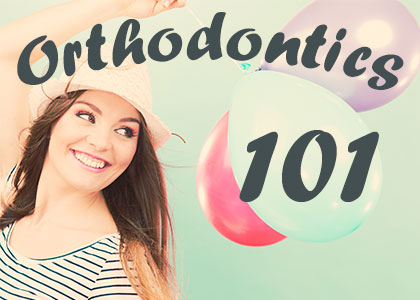Orthodontics 101
Posted on April 13th, 2020
 A healthy, beautiful smile is important for your overall health and life satisfaction. If your teeth are too close to each other, too far apart, too crooked, or if they fit together uncomfortably when your mouth is closed, it’s likely you have malocclusion.
A healthy, beautiful smile is important for your overall health and life satisfaction. If your teeth are too close to each other, too far apart, too crooked, or if they fit together uncomfortably when your mouth is closed, it’s likely you have malocclusion.
From the root words “mal” for bad, and “occlusion” for closed, malocclusion refers to a poor position of your teeth when your mouth is closed. The solution for malocclusion is orthodontics to straighten your teeth. (The root word “ortho” means straight.)
The specific position of your mouth when it’s closed is called your bite. Your bite can be either healthy or unhealthy, and an unhealthy bite can cause all sorts of problems. Kids and adults alike can benefit from fixing an improper bite.
Needing orthodontic treatment is a good example of when cosmetic dentistry is both beautiful and practical. Pleasant Hill dentists Dr. Chad Johnson share all you need to know about getting orthodontic treatment at Veranda Dentistry.
Types of Orthodontic Treatments
An orthodontic dentist will examine your mouth and create a personalized treatment plan to achieve your smile goal. There are numerous kinds of orthodontic treatments—most involve appliances made of plastic, metal, wires and elastic bands to move your teeth and jawbones. These materials—sometimes removable, other times cemented in place—put just the right pressure on your teeth to shift them to a proper position.
Below are the most common orthodontic appliances:
- Braces are probably what you think of when you think of orthodontics. They can be made of metal or ceramic and can be placed on the front of your teeth or behind them.
- Expanders are permanent appliances that increase the space in your mouth.
- Invisalign® is an alternative to braces. These and other clear aligners are made from clear plastic, and removable to give you the same result without the signature “train-track” look in your smile.
- Six Month Smiles® are like traditional braces, but made with clear brackets and tooth-colored wires for a much less noticeable look, and focus on only the front teeth to achieve aesthetic results in just a few months!
- Retainers are removable devices made of plastic and wires molded to fit your teeth and hold them in their new position.
In some cases, your dentist may recommend surgery as part of your orthodontic treatment. Or, the dentist may suggest veneers if it will better and more easily help you achieve the smile you desire.
Benefits of Orthodontics
Malocclusion can cause a lot of problems in your daily life besides feeling embarrassed by crooked teeth. Straightening your teeth and improving your bite can help with:
- Better sleep
- Improved breathing
- Reduced jaw pain & TMJ
- Improved speech including lisp
- Reduced risk of gum disease
- Prevent accidentally biting your cheek
- A more confident smile
Cons of Orthodontics
Some orthodontic treatments cause initial tenderness in your mouth, but this should pass within a few days. Orthodontics can also be hard to afford (see our financing tips below!) You will have to take extra time to properly brush your teeth if you have braces.
You might not want to start a new orthodontic treatment right before a big life change like getting married or starting a new job, so talk with your dentist about ideal timing. But overall, orthodontic treatments are low-risk and provide important, long-term benefits.
Affording Orthodontics
Orthodontics is important for the proper functioning of your mouth, oral health, and a beautiful smile, but you might get sticker shock at the price of treatment. If you need help affording orthodontic care, you have a few options.
- Call your dental insurance company to understand what benefits are provided (or our office is happy to do this for you).
- If you’re not sure you have dental insurance, most states provide free or reduced coverage if your family meets the income requirements.
- You can also ask about payment plans and financing options[LINK] that allow you to pay for your treatment over time instead of all at once.
Is an Orthodontist a Dentist?
Dentistry is the general practice of providing oral health care. Orthodontics is a dental specialty that treats malocclusion and teeth straightening. All orthodontists are dentists, but not all dentists are orthodontists. Many dentists are general dentists providing orthodontic services, including Dr. Chad Johnson.
If you want to see a dentist about problems with your teeth alignment, call us today. We’ll answer any questions you might have. We look forward to helping you straighten your smile!
The content on this blog is not intended to be a substitute for professional medical advice, diagnosis, or treatment. Always seek the advice of qualified health providers with questions you may have regarding medical conditions.
*Dr. Chad Johnson are general dentists providing orthodontic services.


